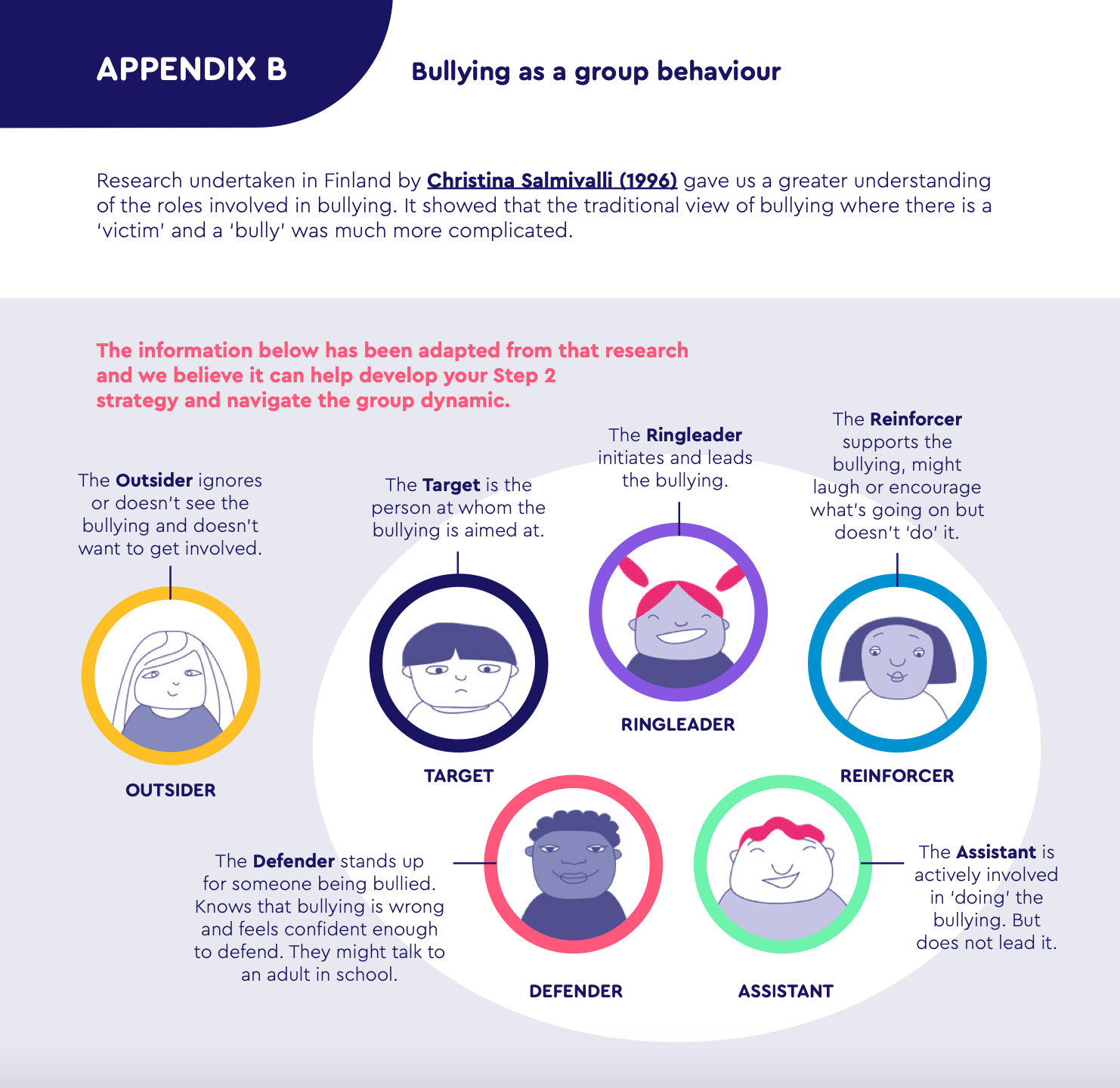Evidence shows that the negative consequences of experiencing bullying can last well into adulthood. Those who are bullied are more likely to earn less money in their lives, access mental health services as adult, not be in a stable relationship and achieve fewer academic qualifications. These outcomes get significantly worse for those people that have been severelybullied. Timely and well planned responses to bullying can have a positive affect on lessening the negative impact of bullying on those who experience it.
This tool provides guidance for schools and other settings about how to develop their response to bullying incidence. It is based around ABA’s 3-step response to bullying framework. We believe that by recording your responses using this tool, it will help evidence your response, improve the quality of responses, identify trends and enable the school to reflect and ultimately stop bullying sooner.
The next three pages outline the key questions and considerations that should be made at each step of the process, which can be used as a framework to help you develop the best possible response to bullying in your setting. At the end of this document there are appendices which aim to provide practical ideas, examples and further information on the evidence that has been used to develop this tool.
Whilst we know that every setting is different, we strongly encourage you to incorporate this into your existing practice to ensure that every incident of bullying is dealt with as effectively and consistently as possible.
ABA has an online CPD course about responding to bullying which is free to access
STEP 1 – Safety of those directly involved
Bullying can have a long lasting impact on a young person’s mental health for those who are getting bullied, witnessing bullying and doing the bullying. That is why our first step is about securing and ensuring the safety and wellbeing of those involved. Below are some questions that should be asked at this stage. It is important to have a record of these considerations.
In most bullying situations you do not need to use outside agencies such as social workers or police however this should always be considered. Young people often tell us that at this stage they aren’t asked what they would like to happen. So it’s important to involve them along the way.
A. Are all pupils involved safe?
B. Is anyone’s physical health or wellbeing at risk?
C. Have you needed to use the child protection policy?
D, Did you access any outside support? E.g. NHS, police.
E. Have you recorded the incidents themselves (see Appendix A)?
F. Did you tell the pupil/s being bullied that you are taking it seriously, it’s not their fault and they don’t have to put up with bullying?
G. Have you asked the pupil/s being bullied how they’re feeling and how they think it can be resolved?
H. Have you informed the pupil/s being bullied what you will do next?
STEP 2 – Preventing the bullying from reoccurring
Once you’ve secured the safety of those involved, the next step is about working with the group of individuals involved to prevent the bullying from reoccurring. Bullying is a group behaviour. It rarely happens between two individuals in isolation. So it’s important to consider the wider peer group at this stage. We use Salmivalli’s Role Participant Scale here to help us identify the group and work with those involved. You can see Appendix B for more information about these roles. At step 2, you should work through the activities below to develop a peer strategy. Make sure you record your actions, involve pupils and keep your actions in regular review. you can use Appendix C to help you.
A. Record names based on the roles involved in bullying (See Appendix B), how they were involved and what you could do to change their behaviour (See Appendix C for template).
B. Have you been clear what steps you are taking with those involved?
C. Have you developed a strategy together with the target and are they happy with your agreed way forward?
D. Have you sought agreement from all those involved about the way forward? Sometimes this could be done with a signed agreement by those involved or simply a conversation but it is important to record this agreement.
E. Have you regularly checked in with the target/s? Do they have a discreet way to report to you about how they are feeling at school regularly? Have you talked to parents/carers?
F. Is your response built upon changing the behaviour of the group and not solely on changing the behaviour of the Target/s? This is important to avoid sending a message to the target that the bullying is their fault.
STEP 3 – School learning and reflection
This is an important step. It allows us to reflect upon our school practice to ascertain if there is anything we can do to prevent a similar situation in the future. Steps 2 and 3 can and should happen concurrently. You don’t have to wait to ‘fix’ the issue amongst the group before you implement the learning and reflection step. Spend some time on reflecting on the incidents. Ask yourselves: What has this incident taught us? Does this reveal any issues in school? E.g. do you have an issue with language in school or an area within the school which needs more adult supervision • Do staff need any training? Remember to think across the whole staff team and include after school/breakfast club providers and break time staff.
STEP 2 STEP 1
• Do you need to refresh your school policy and procedures? Have you identified any gaps?
• Do parents have a good understanding of what bullying is and isn’t? Do they know the school approach to anti-bullying?
C. What needs to happen/who do you need to speak to in order to make this happen? By when and how?
APPENDIX A Sample School Bullying Log
This sample log aims to give you advice about the things that should be included in your record of bullying. You will want to edit and make it work for your school/setting but remember
that it is important to record your actions to ensure the safety of pupils, understand levels of bullying amongst young people and to be able to evidence actions taken.
APPENDIX B Bullying as a group behaviour
Research undertaken in Finland by Christina Salmivalli (1996) gave us a greater understanding of the roles involved in bullying. It showed that the traditional view of bullying where there is a ‘victim’ and a ‘bully’ was much more complicated.
APPENDIX C Sample ‘Roles involved in bullying’ Record
This sample record is aimed to help you use the roles explained in Appendix B to identify routes to influence more positive behaviours amongst pupils. Keep this record in review and involve young people in developing the strategy.











